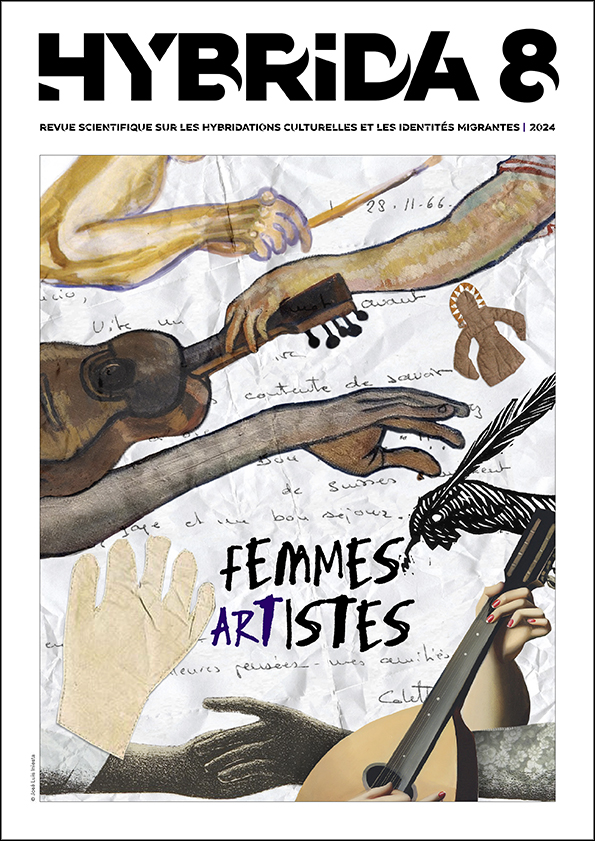The affective side of the mental state of women artists at the turn of the 20th century: Camille Claudel
DOI:
https://doi.org/10.7203/HYBRIDA.8.28382Keywords:
Forgotten women artists, artistic challenge, genius and madness, subversive creativity Abstract
Abstract
A talented artist, author of works that marked the history of sculpture, she died of hunger in an asylum and was buried in a mass grave; she sank into madness and deep oblivion for decades. How can we explain such a tragic fate? In our analysis to answer this question, we will make frequent allusions to the two main film productions based on her life: Camille Claudel and Camille Claudel 1915.
 Downloads
Downloads
 References
References
Béné, Isabelle. (2018). Camille Claudel : Femme enfermée. Diplômées, (264-265), 137–180.
Bougueret, Florence. (20 mai 2012). Sociologie / Femmes artistes et images de femmes. Papiers Universitaires. https://papiersuniversitaires.wordpress.com/2012/05/20/sociologie-femmes-artistes-et-images-de-femmes-par-florence-bougueret/
Bueltzingsloewen, Isabelle. (2002-2004). Les « aliénés » morts de faim dans les hopitaux psychiatriques français sous l’Occupation. Vingtième Siècle. Revue d’histoire, 76(4), 99–115. https://doi.org/10.3917/ving.076.0099
Callahan, Shannon R. (2015). Beyond Rodin: Revisiting the legacy of Camille Claudel [Student Publications. Paper 327]. The Cupola: Scholarship at Gettysburg College, Gettysburg. https://cupola.gettysburg.edu/cgi/viewcontent.cgi?article=1405&context=student_scholarship
Cellard, André. (1991). Histoire de la folie au Québec de 1600 à 1850. Boréal.
Julie et Chaïneze. (29 mai 2009). Camille Claudel ou la place de la femme artiste au XIXe siècle. Le blog blogcdicassin. http://blogcdicassin.over-blog.com/article-32012949.html
Claudel, Paul. (1954). Mémoires improvisés. Gallimard.
Cooper, B. (2008). Camille Claudel: trajectory of a psychosis. The Journal of Medical Ethics and Medical Humanities, 34(1), 25–29. https://doi.org/10.1136/jmh.2008.000268
CulturePsyP7. (2016). Lettres de Camille Claudel aux médécins, 28 décembre 1913/25 février 1917. Culture Psy P7 - Psychanalyse et culture contemporaine. https://culturepsyp7.wordpress.com/2016/12/12/lettres-de-camille-claudel-aux-medecins/
Dayot, Armand. (1897). Camille Claudel. In Le long des routes : récits et impressions (pp. 246–249). Éditeur Ernest Flammarion. https://gallica.bnf.fr/ark:/12148/bpt6k96235g.pdf
Dumont, Bruno. (Réalisateur). (2013). Camille Claudel 1915 [Film]. [DVD]. 3B Productions.
Duplan, Antoine. (14 mai 2013). Trois jours en enfer avec Camille Claudel. Le Temps. https://www.letemps.ch/culture/trois-jours-enfer-camille-claudel
Ellis, Sarah Stickney. (1845). The Family Monitor and Domestic Guide: Women of england, daughters of england, wives of england, mothers of England. Henry G. Langley.
Erlij, Evelyn. (2014). Escribir el Pasado con el Lente de una Cámara: el Cine como Documento Histórico. Comunicación y medios, (29), 76–91. https://doi.org/10.5354/rcm.v0i29.30153
Escoffier-Lambiotte, Claudine. (1987). Les asiles de la mort. Quarante mille victimes dans les hôpitaux psychiatriques pendant l’Occupation. Le Monde.
Lafont, Max. (1987). L’extermination douce. La mort de 40.000 malades mentaux dans les hôpitaux psychiatriques en France, sous le régime de Vichy. Éditions de L’AREFPPI.
Le Normand-Romain, Antoinette. (2005). Camille, ma bien-aimée malgré tout. In Porter, J.R. & Vilain, J. (ed.), Camille Claudel & Rodin, la rencontre de deux destins. Hazan.
Libert, Louise-Marie. (2014). Les plus mauvaises mères de l’Histoire : Légendes, crimes et vérités. La Boîte à Pandore.
López Fernández, María. (2007). Una artista llamada Camille Claudel. In Camille Claudel [1864-1943]. Cuaderno nº 26, Fundación Mapfre.
Mayayo, Patricia. (2019), Historias de mujeres, historias del arte. Cátedra.
Nantet, Marie-Victoire. (2003). Camille Claudel par elle-même. Bulletin de la Société Paul Claudel, (172), 36–63. http://www.paul-claudel.net/bulletin/bulletin-de-la-societe-paul-claudel-n%C2%B0172
Nochlin, Linda. (1971). Why have there been no great women artists? A shortened version of an essay. In Vivian Gornick et Barbara K. Moran (ed.), Woman in Sexist Society: Studies in Power and owerlessness (pp. 344–366). Basic Books.
Nuytten, Bruno (Réalisateur). (1988). Camille Claudel [Film]. [DVD]. Lilith Films I.A., Gaumont, Films Christian Fechner.
Ortega Ruiz, Cristina. (2012). Las mujeres y la enfermedad mental. Una perspectiva de género a través de la historia contemporánea. Cuadernos Koré. Revista de historia y pensamiento de género 1(4), 208-223. https://e-revistas.uc3m.es/index.php/CK/article/view/1501
Retg, Cécile. (2018). Femmes et folie d’hier à aujourd’hui : psychiatrie et contrôle social. RQASF Réseau québécois d’action pour la santé des femmes. https://rqasf.qc.ca/femmes-et-folie-dhier-a-aujourdhui-psychiatrie-et-controle-social/
Ríos Guardiola, María-Gloria. (2015). De la genialidad a la locura: Séraphine de Senlis et Camille Claudel. In Locas, escritoras y personajes femeninos cuestionando las normas [Ponencia]. XII Congreso Internacional del Grupo de Investigación Escritoras y Escrituras, (pp. 1326–1341). https://idus.us.es/bitstream/handle/11441/55525/Pages%20from%20libro%20locas-8.pdf?sequence=1&isAllowed=y
Rivière, Anne & Gaudichon, Bruno. (ed.) (2003). Camille Claudel. Correspondance. Gallimard, coll. Arts et Artistes.
Rouard, Elise. (2017). L’hécatombe des fous. Télérama. https://www.telerama.fr/cinema/films/lhecatombe-des-fous,n6428561.php
Baÿt-Darcourt, Céline. (Présentatrice). (17-05-2018). Élise Rouard : «Le régime de Vichy estimait qu’il y avait des malades plus intéressants à sauver» [audio en podcast]. In franceinfo / Radio France. https://www.francetvinfo.fr/replay-radio/info-medias/info-medias-elise-rouard-le-regime-de-vichy-estimait-quil-y-avait-des-malades-plus-interessants-a-sauver_2732597.html
Saunier, Mathilde. (31 juillet 2018). L’entrée des femmes à l’école des Beaux-arts. Deuxième temps. Revue numérique d’histoire de l’art. https://alheuredelart.wordpress.com/2018/07/31/entree-des-femmes-ecole-beaux-arts/
Sorlin, Pierre. (2005). El cine, reto para el historiador. Istor, (20), 11–35. http://www.istor.cide.edu/archivos/num_20/dossier1.pdf
Spadone, Christian et Olié, Jean-Pierre. (1993). Les nouveaux visages de la folie. Odile Jacob.
Supino Viterbo, Valentina. (1999). L’enfant mal aimé. Flammarion.
Zhang, Christophe. (novembre 2017). Què se n’ha fet de les dones artistes? Un anàlisi de les desigualtats entre dones i homes en el món de l’art. https://educaciodigital.cat/ioc-batx/moodle/pluginfile.php/6680/mod_resource/content/3/dones_artistes.pdf
Downloads
Published
How to Cite
-
Abstract107
-
PDF (Français )63
Issue
Section
License
![]()
All the documents in the OJS platform are open access and property of their respective authors.
Authors publishing in the journal agree to the following terms:
- Authors keep the rights and guarantee HYBRIDA the right to be the first publication of the document, licensed under a Creative Commons license Attribution-NonCommercial-ShareAlike 4.0 International (CC BY-NC-SA 4.0) that allows others to share the work with an acknowledgement of authorship and publication in the journal.
- Authors are allowed and encouraged to spread their work (once published) through electronic means using personal or institutional websites (institutional open archives, personal websites or professional and academic networks profiles) once the text has been published.
















